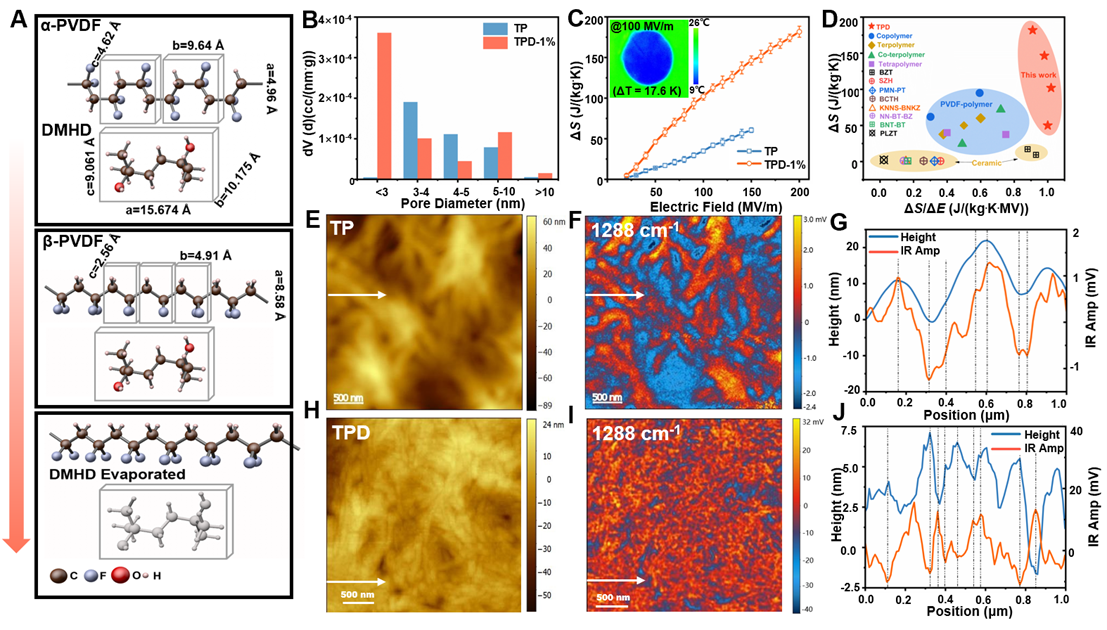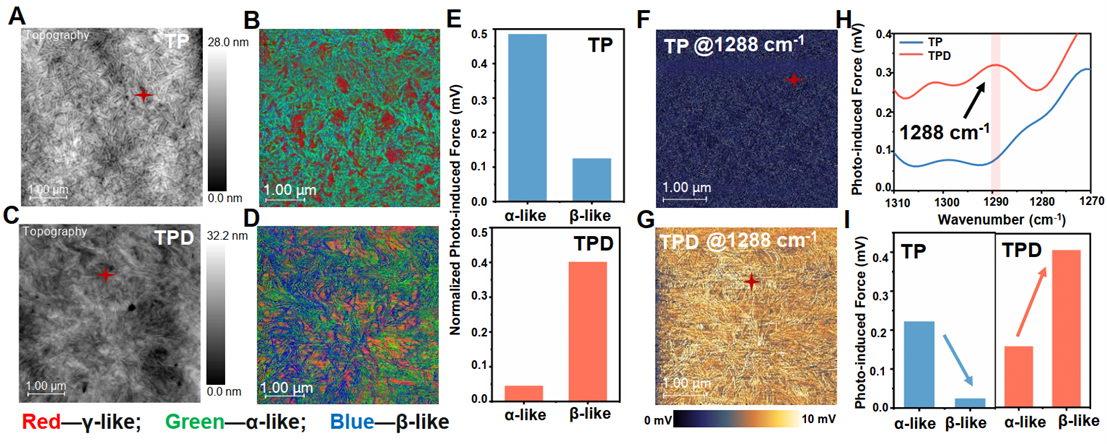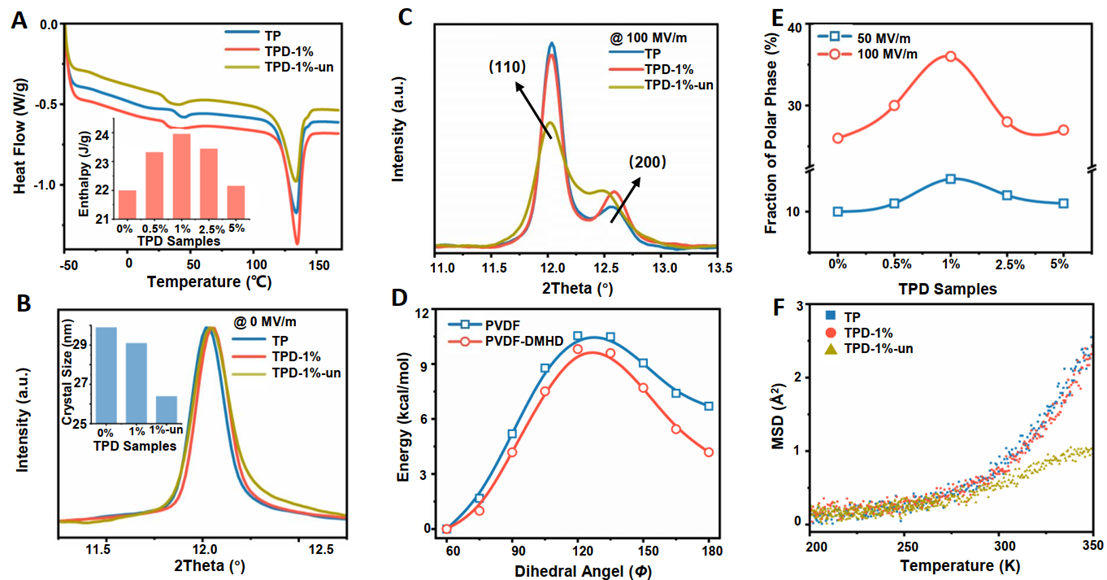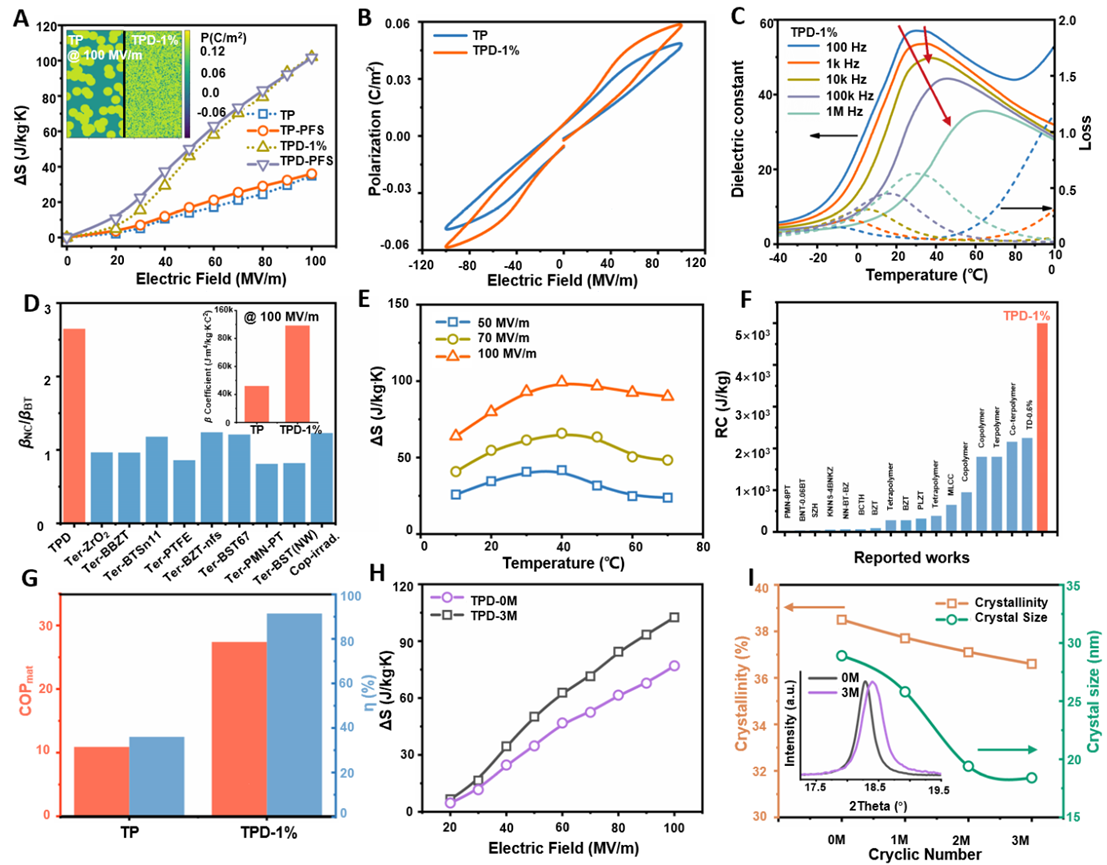
News

News
The electrocaloric effect (ECE) represents a unique phenomenon of condensed matter physics. Insulating polar materials exhibit an alternating temperature change under the cycling of the electric field, forming a thermal dynamic cycle that is similar to the conventional gas compress refrigeration. Ideally as a solid-state refrigeration, the electrocaloric refrigeration is known for its potential low power consumption, high coefficient of performance (COP), zero global warming potential (GWP), and the advantages in miniaturization for applications asking for light-weight. However, this promising technology requires giant electrocaloric temperature change of the polar material, under an ultra-low electric field for enabling the practical application.
A research team led by Prof. Xiaoshi Qian in School of Mechanical Engineering at Shanghai Jiao Tong University achieved an exceptionally large ECE under a relatively low electric field. By developing a topological interface-epitaxy technique in a polymeric ferroelectric, they induced extensive formation of polarized interfaces in ferroelectric polymers through the introduction of small molecule crystal sacrificial layers. This technique has led to a substantial polar entropy changes in the polymers when subjected to external electric fields, achieving a colossal EC-induced temperature change over 38 K, near the room temperature. The ECE was 4-fold of that of the commercially available EC polymers. The paper was published as a research article entitled "Colossal electrocaloric effect in an interface-augmented ferroelectric polymer" in Science on December 1, 2023 【Science 382, 1020–1026 (2023)】.
Earlier in 2021, the same team reported that by chemically inducing C=C bonds in the relaxor ferroelectric polymers, they could reduce the size of relaxor ferroelectric domain sizes, and lower the energy barrier between two polar entropy states, and achieve a large ECE at low field. 【Nature 600, 664–669 (2021)】The resulted crystalline sizes are in the range of 100-20 nm. However, due to the complicated crystallization processes of relaxor ferroelectrics, the hope of further enhance ECE by further reducing the domain size has met its technical bottleneck.
In this work, the team focusing more on the internal interface of the polar material rather than the 3 dimensional bulk crystals. In order to create the internal polar interfaces, they blended low-boiling-point polyol organic small molecules DMHD into relaxor ferroelectric terpolymers. Leveraging the intermolecular interactions between these components, they induced the self-assembly of the polymer's non-polar interfaces into polar conformations at the heterogeneous interfaces. This approach introduced an abundance of small, sub-nanometer polar pore with huge surface area of polar interfaces, significantly enhancing the material's entropy change. At a low electric field, the modified material achieved an entropy change of 100 J/(kg·K) which was four times greater than that of ordinary polymers, with an electrocaloric strength exceeding 1 J/(kg·K·MV), and demonstrated a cooling capacity of 5×103[a1] J/kg, maintaining stable cyclic operation over 3 million cycles.

Figure 1. The polymer interface enhancement effect induced by DMHD molecules exhibits a colossal electrocaloric performance
Nanoscale infrared imaging revealed that the nanopore interfaces retained polar configurations due to the intermolecular hydrogen bonding interactions. Compared with traditional relaxation ferroelectric polymers, these polar conformations appear at the edge of the grain rather than in the middle of the grain. The dense subnanometer-sized two-dimensional polar interface replaces the hundred-nanometer-sized three-dimensional polar nanodomain domain, which is the main contributor to the ECE.

Figure 2. Infrared Photoinduced Force Microscopy (IR-PiFM) characterization of interface-enhanced polar and non-polar conformations
The team utilized the photonic infrared hyperspectral imager (hyPIR) to capture the infrared absorption chemical images of electrocaloric polymers within the spectral range of 1600-780 cm-1. This technique allows the direct observation of the material's interface-enhanced polar high-entropy state and other polymer conformations. The modified samples exhibited not only a distinct enhancement of all-trans polar conformations but also formed a greater variety of polymer conformations, demonstrating stronger multiphase coexistence characteristics. Compared to ordinary polymers, modified sample respond more sensitively to electric fields, thereby exhibiting a more pronounced electrocaloric effect.

Figure 3. Structural analysis of interface-enhanced polymers versus conventional polymers.
In situ Wide-Angle X-ray Diffraction (WAXD) studies under electric fields have investigated the dynamic transitions of the 3D bulk crystalline structures, showing that the introduced DMHD small molecules indeed induce a strong phase transition. Density Functional Theory (DFT) and Molecular Dynamics (MD) models also intuitively demonstrate that DMHD can lower the potential barrier for the non-polar to polar phase transition due to the presence of interface hydrogen bonding interactions.
Elastic Neutron Scattering results show that TPD-un (before annealing) has the smallest mean square displacement, indicating that hydrogen ions are closely confined near the surface of small molecules. By sacrificing DMHD, a large surface area of polar conformation interfaces is released, which encourages the TPD samples to exhibit the colossal electrocaloric effect.

Figure 4. The dielectric behavior and cyclic performance of the modified terpolymers.
The Landau-Ginzburg-Devonshire thermodynamic model, supplemented with phase-field simulations, was employed to quantitatively understand the experimentally ECE results. Analysis of the dielectric properties, with observed increases in polarization strength and dielectric constant, confirms the presence of interface-enhanced effect. Moreover, the dielectric breakdown field also improved by nearly 150%, favoring practical cyclic operation in electrocaloric refrigeration. The polar conformations created by DMHD used as a sacrificial agent, enhanced the overall dielectric performance of the material without introducing various complications associated with permanent composite fillers. The modified nanoporous polar interfaces exposed in unconstrained free volumes, significantly improved the contribute to the entropy per unit polarization.
The colossal electrocaloric effect (ECE) in TPD is independent of temperature around room temperature and covers an effective temperature window from 10°C to 70°C, thus yielding the maximum Refrigerant Capacity (RC). Compared to conventional polymers, the coefficient of performance (COPmat) of TPD is increased by 250%, and the cyclic life of up to 3 million cycles (more than 70 days). This enhancement could further reduce the size and weight of power sources, powering potential portable electrocaloric cooling devices.
The research was supported by multiple teams, including in-situ X-ray scattering experiments at the Shanghai Synchrotron Radiation Facility and quasi-elastic neutron scattering experiments conducted by the team of special researcher Liang Hong from the School of Physics and Astronomy at Shanghai Jiao Tong University. Additionally, Professor Jiangping Chen from the School of Mechanical Engineering, Houbin Huang from Beijing Institute of Technology and Yurong Yang from Nanjing University provided important support for this research. Moreover, Molecular Vista Company and Bruker (Beijing) Scientific Technology Co., Ltd. also participated in research related to nanoscale infrared studies.
The research was supported by the National Key R&D Program, the National Natural Science Foundation of China, Natural Science Foundation of Shanghai. The work was also funded by the State Key Laboratory of Mechanical System and Vibration, the Oceanic Interdisciplinary Program and the Prospective Research Program at Shanghai Jiao Tong University. Experimental resources were provided by the Student Innovation Center and the Instrumental Analysis Center of Shanghai Jiao Tong University, the Shanghai Synchrotron Radiation Facility BL19U2 and BL16B1 beamlines, as well as the Australian Centre for Neutron Scattering.
Paper link:https://www.science.org/doi/10.1126/science.adi7812

Shanghai Jiao Tong University
Address: 800 Dongchuan Road, Shanghai
200240